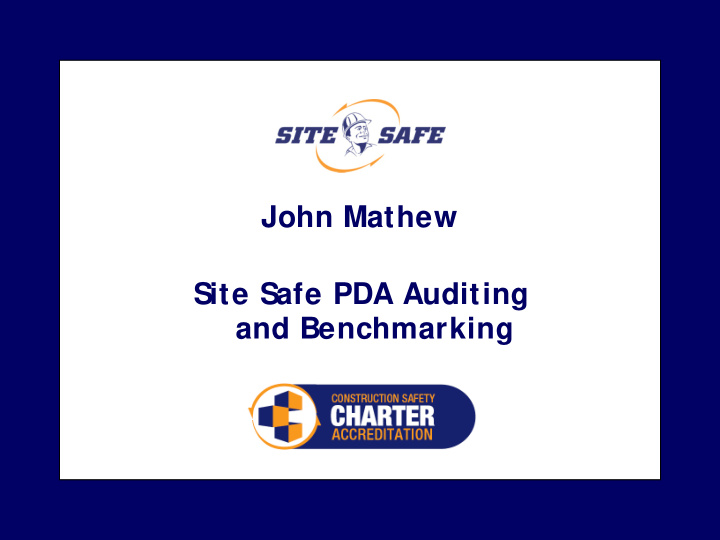



John Mathew Site Safe PDA Auditing and Benchmarking
Estimating Ambush “They couldn’t hit us at this distance… ” The final est imat e and last words of General John S edgwick before he was shot overlooking his parapet in 1864 during America’ s Civil War.
Why Benchmarking? • Enables a fact-based philosophy of decision-making and continuous improvement • Provides a framework for establishing KPI’ s through comprehensive measures • Longitudinal analysis provides a perspective on performance over time
Benchmark Reports PDA Audit & Benchmarking Audit Reports Service
Audit Report
Safety Improvement Report
Company Summary Report
Benchmark by Project Value
Benchmark by Region
Benchmark by Stage of Completion
Benchmark Site by Site Performance
Benchmark Site Specific Activities
Benchmark Construction Activities Scaffold Safety
Accessing Benchmarking Reports
Accessing Benchmarking Reports
Accessing Benchmarking Reports
Provide a Pathway for Continuous Improvement Charter Accreditation Performance Tiers Tier One: S afety S ystems Tier Two: S afety Behaviours Tier Three: S afety Leadership - 2009
Define Key Performance Indicators of Best Practice in NZ Construction Tier One – Site Specific Safety Plan 1. Tender Documents 6. Toolbox Talks 2. S afety Plans 7. S afety Audits 3. Hazard ID & Control 8. Training Register 4. S afety Training 9. Accident Register 5. S ite S afety Meetings 10. S ubcontractor Monitoring
Define Key Performance Indicators of Best Practice in NZ Construction Tier Two – Safety Behaviours 1. Facilities 13. Chemicals 2. Housekeeping 14. Fall Prevention 3. Personal Protective Equipment 15. Harness Use 4. Excavation & Trenches 16. Ladders 5. Falsework/Formwork 17. Scaffolds 6. Welding & Gas Cutting 18. Elevated Work Platforms 7. Demolition 19. Equipment & Machinery & Tools 8. Sun Exposure 20. Crane & Lifting Appliances 9. Noise 21. Powder-Actuated Tools 10. Confined Space 22. Electrical 11. Cement & Concrete 23. Environmental Issues 12. Asbestos 24. Traffic Management
Define Key Performance Indicators of Best Practice in NZ Construction Tier Three – Safety Leadership 1. Organisational KPI’ s 2. Defined management responsibilities 3. Communicated responsibilities 4. Evidence of management participation 5. Performance feedback and recognition
Recognise Companies Performing at a High Level Tier 1 Performance Threshold ‐ 65% 100.00% 100.00% 80.00% 63.48% 60.00% 30.80% 40.00% 20.00% 0.00% Max S core Average S core Min S core Tier 2 Performance Threshold ‐ 80% 93.20% 100.00% 80.48% 80.00% 60.00% 60.00% 40.00% 20.00% 0.00% Max S core Average S core Min S core
The Audit Process • Initial Accreditation Audits – 1-3 active sites = 2 audits – 4 or more active sites = 4 audits • Ongoing Accreditation Audits – Up to $200 million = 4 audits – $200 million - $300 million = 6 audits – Over $300 million = 8 audits • NZIM Qualified Auditors
Construction Safety KPIs Construction S afety KPIs Tendered Safety Requirements 10 0 % Subcontractor Monitoring Site Specific Safety Plans 8 0 % 6 0 % 4 0 % Accident Reporting Hazard ID and C ontrol 2 0 % 0 % Pas s port and Higher L evel Training Regis ters Training Self Ins pections Project Safety Meetings Tool Box Talks
Client Application • Legal responsibility – Take All Practicable S teps to ensure Contractors are not harmed • Benefits of S afety – Best Value – Efficiency, quality, relationships, problems, delays, accidents • Convenient method of pre-qualifying and selecting Contractors – S treamline the screening process
Recommend
More recommend